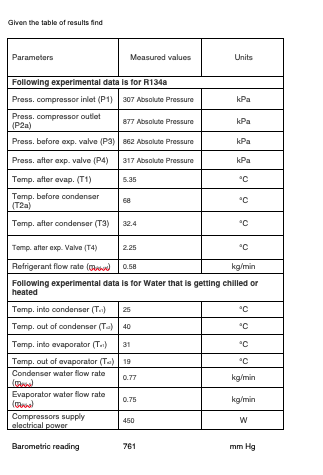Rate of heat transfer to evaporator from the chilled water: Rate of heat transfer from condenser to the cooling water: Rate of heat transfer to refrigerant in “Evaporator” using enthalpy values: Rate of heat transfer from refrigerant in “Condenser” using enthalpy values Work input from the compressor to the refrigerant using enthalpy values COP from enthalpy changes across work input and evaporator COP from motor electrical power input as work and rate of heat transfer to the chilled water
Rate of heat transfer to evaporator from the chilled water: Rate of heat transfer from condenser to the cooling water: Rate of heat transfer to refrigerant in “Evaporator” using enthalpy values: Rate of heat transfer from refrigerant in “Condenser” using enthalpy values Work input from the compressor to the refrigerant using enthalpy values COP from enthalpy changes across work input and evaporator COP from motor electrical power input as work and rate of heat transfer to the chilled water
Refrigeration and Air Conditioning Technology (MindTap Course List)
8th Edition
ISBN:9781305578296
Author:John Tomczyk, Eugene Silberstein, Bill Whitman, Bill Johnson
Publisher:John Tomczyk, Eugene Silberstein, Bill Whitman, Bill Johnson
Chapter23: Compressors
Section: Chapter Questions
Problem 9RQ: Describe the reciprocating compressor piston, rod, crank-shaft, valves, valve plate, head, shaft...
Related questions
Question
Given the table of results find the following. Give answers in KW.
Please use tables and please refer to which table you use ..I need to understand be able to do
Please show all working out and explain how you come up with values for h1, h2, h3, h4 (eg which table you use )
- Rate of heat transfer to evaporator from the chilled water:
- Rate of heat transfer from condenser to the cooling water:
- Rate of heat transfer to refrigerant in “Evaporator” using enthalpy values:
- Rate of heat transfer from refrigerant in “Condenser” using enthalpy values
- Work input from the compressor to the refrigerant using enthalpy values
- COP from enthalpy changes across work input and evaporator
- COP from motor electrical power input as work and rate of heat transfer to the chilled water

Transcribed Image Text:Given the table of results find
Parameters
Measured values
Units
Following experimental data is for R134a
Press. compressor inlet (P1) 307 Absolute Pressure
kPa
Press. compressor outlet
(P2a)
877 Absolute Pressure
kPa
Press. before exp. valve (P3) 862 Absolute Pressure
kPa
Press. after exp. valve (P4)
317 Absolute Pressure
kPa
Temp. after evap. (T1)
5.35
Temp. before condenser
(T2a)
68
Temp. after condenser (T3)
32.4
Temp. atter exp. Valve (T4)
2.25
Refrigerant flow rate (d
kg/min
0.58
Following experimental data is for Water that is getting chilled or
heated
Temp. into condenser (T.)
25
Temp. out af condenser (Ta) 40
Temp. into evaporator (T)
31
Temp. out of avaporator (Ta) 19
Condenser water flow rate
0.77
kg/min
Evaporator water flow rate
0.75
kg/min
(al
Compressors supply
| electrical power
450
Barometric reading
761
mm Hg
Expert Solution
This question has been solved!
Explore an expertly crafted, step-by-step solution for a thorough understanding of key concepts.
Given data
VIEWRate of heat transfer to the evaporator from the chilled water
VIEWRate of heat transfer from condenser to the cooling water:
VIEWRate of heat transfer to refrigerant in “Evaporator” using enthalpy values:
VIEWRate of heat transfer from refrigerant in “Condenser” using enthalpy values
VIEWWork input from the compressor to the refrigerant using enthalpy values
VIEWCOP from enthalpy changes across work input and evaporator
VIEWCOP from motor electrical power input as work and rate of heat transfer to the chilled water
VIEWStep by step
Solved in 8 steps with 2 images

Recommended textbooks for you

Refrigeration and Air Conditioning Technology (Mi…
Mechanical Engineering
ISBN:
9781305578296
Author:
John Tomczyk, Eugene Silberstein, Bill Whitman, Bill Johnson
Publisher:
Cengage Learning

Refrigeration and Air Conditioning Technology (Mi…
Mechanical Engineering
ISBN:
9781305578296
Author:
John Tomczyk, Eugene Silberstein, Bill Whitman, Bill Johnson
Publisher:
Cengage Learning